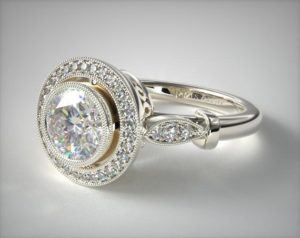Before you buy a ring with a diamond or gemstone, you need to decide on the type of setting. Choosing a setting is important as it determines how securely the stones will be held in place, how visible they will be, and how easy the ring will be to clean and care for, among others. Let’s see what types of ring settings there are and take a look at their pros and cons.
Here are some of the most popular settings for diamond/gemstone rings:
Prong Settings

A ring with a prong setting
The prong setting is one of the most popular settings for rings. Prongs are basically metal pins that hold the stone in place.
Prong settings are usually made with four or six prongs. There are also designs with eight prongs.
In general, the more prongs a setting has, the safer it is, as there are more prongs that keep the stone from falling off the setting. Fewer prongs make a setting less secure, but they also make the diamond or gemstone more visible.
Advantages: Prongs take up a small area of the stone and leave most of its surface visible. This is especially important when it comes to diamonds, as their brilliance depends on how much light can enter them and be reflected back.
Disadvantages: A problem with prongs is that sometimes they can catch on clothes or hair. This usually happens when the prongs are worn out or loose – in such cases, prongs get bent and stick out. To avoid this, have your prongs regularly inspected every couple of years and get them repaired or tightened if needed.
If the wearer is going to wear the ring every day, or if she works with her hands or engages in vigorous activities, a prong mounting in which the stone is set lower and closer to the shank is a safer choice as opposed to a mounting that is set higher and farther away from the shank.
The Tiffany Setting
The Tiffany setting is a type of prong setting. It has six prongs and is designed to enhance the brilliance of the diamond mounted in it by achieving maximum light return.
This setting was created by Tiffany & Co. and cannot be reproduced by any other company as the setting itself is trademarked. Many jewelers offer settings that are quite similar in design, however.
Advantages and disadvantages: The pros and cons of this type of setting are pretty much the same as those associated with all prong settings. Please see the section dedicated to prong settings above.
Bezel Settings
The bezel setting is another popular design. This setting holds the diamond or gemstone with a strip of metal that is wrapped around the stone.

A ring with a bezel setting
There are two types of bezel settings – the full bezel setting and the partial bezel setting.
The full bezel setting encircles the stone entirely, along its circumference. This type of bezel setting is the safest, but it also conceals a significant part of the stone.
The partial bezel setting does not cover the entire edge of the stone – it leaves its sides visible. The parts of the stone that are not covered are exposed to potential blows and hits that could be damaging, but more of the diamond or gemstone is visible compared with the full bezel setting.
Advantages: The bezel setting provides much better safety in comparison to prong settings. The stone is well protected and is less likely to get damaged when worn.
Disadvantages: The bezel setting hides more of the stone compared to a prong setting. So if you’re buying a diamond ring, for example, you should decide what is more important: the safety or visibility of the stone. As you can see, there is a tradeoff between these two features.
Solitaire Setting

A solitaire ring with a diamond (James Allen)
Solitaire settings have a single center stone. This type of setting is one of the most popular, as it emphasizes the diamond or gemstone mounted in it.
Solitaire settings are often made with prongs. There are also many solitaires made with bezels.
Advantages: The solitaire setting focuses the attention on the single stone mounted in it. There are no side stones. The ring is simple and easy to clean and maintain.
Disadvantages: Although there are no side stones to distract from the center stone, the lack of additional stones also means forgoing the opportunity to enhance the center stone’s brilliance and sparkle. And smaller stones cost less for the same total carat weight – for example, a 0.50 ct diamond with two 0.25 ct smaller side stones (1.00 ct in total) would be cheaper than a single 1.00 ct diamond of the same quality.
A solitaire ring will have additional pros and cons specific to the kind of setting holding the stone – prong, bezel, or another type of setting. You can read the appropriate sections in this article pertaining to the respective settings for more information.
Tension Setting

A ring with a tension setting
The tension setting holds the diamond or gemstone by pressing it between two metal bands. This pressure is what keeps the stone in its place, and this is also where the name of this setting comes from.
Each tension setting is specially designed to fit the dimensions of the stone it has to hold.
Advantages: Tension settings look great, unique, and unusual. They provide pretty good visibility for the diamond or gemstone set in them.
Disadvantages: A good and safe tension setting can be complicated and relatively expensive to make since the jeweler has to ensure that the two bands fit exactly the dimensions of the diamond or gemstone. The classical tension setting is also less secure than a typical bezel or prong setting, so the wearer has to be careful not to damage the stone, especially if working with her hands. Resizing the ring or setting a new stone in it can be difficult depending on the setting.
Some of the disadvantages of the classical tension setting are addressed by its modified version – the tension-style setting. This setting looks like the typical tension setting but holds the stone in a bezel or prong setting, which is attached to the two metal bands of the ring. This type of setting is safer than the classical tension setting.
Three-Stone Setting

A diamond ring with a three-stone setting (James Allen)
The three-stone setting is very popular. Most commonly, it has a center stone surrounded by two side stones, which can be smaller or the same size. This setting is a great choice for a diamond ring and for occasions such as a wedding or an engagement.
The diamonds or gemstones in the mounting can be held by prongs, bezels, or another type of setting. Read about the pros and cons of each of these settings in the respective sections above.
Advantages: The additional side stones in a three-stone setting add more brilliance and sparkle to the ring and enhance the center stone, especially when this stone is a diamond.
Disadvantages: More stones in a ring mean more parts to clean and maintain, so a three-stone setting needs extra attention when it comes to care. Also, if you would like the center stone in the ring to stand out, make sure that the side stones do not overpower it in terms of size, sparkle, or color.
Cathedral Setting

A cathedral setting – side view
The cathedral setting mounts the stone high above the ring’s shank. The diamond is held by arches of metal, and this is where the name of this setting comes from.
In a cathedral setting, the center stone itself is usually held with prongs or a bezel.
This type of setting is one of the most popular. Many people prefer it for engagement or wedding rings.
Advantages: Since mounting the center stone high above the body of the ring puts an emphasis on the stone, a cathedral setting can create the illusion of size and make the diamond or gemstone appear larger.
Disadvantages: Setting the center stone high makes it more vulnerable to potential accidental hits and blows, especially if the wearer does a lot of work with her hands. The added height also makes this setting more prone to catching on clothing or other objects.
Any additional advantages or disadvantages depend on how the center stone is held in the setting – with prongs, with a bezel, or in some other way.
Halo Setting

A diamond ring with a halo setting (James Allen)
The Halo setting is a style in which the center stone is surrounded by smaller diamonds or other stones. You can have single and double halo settings – the former has only one circle of stones surrounding the center stone, while the latter has two.
Advantages: The halo setting can increase the overall sparkle of a diamond ring. This setting is a good option if the center stone is small and you want to enhance its appearance. A halo setting can also be a cheaper alternative to buying a bigger center stone – a 0.70-carat diamond surrounded by small diamonds that are 0.30 carats in total would be cheaper than a single 1-carat diamond, all else being equal. This is because bigger stones are rarer and much more expensive.
Disadvantages: Halo settings are somewhat trickier to maintain and clean compared to settings with fewer stones.
Cluster Setting
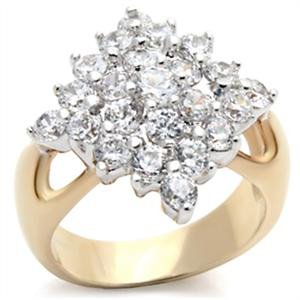
A ring with cluster-set stones
The cluster setting is made up of smaller stones clustered together. It is somewhat similar to the halo setting.
A cluster setting can have a bigger center stone surrounded by a cluster of smaller stones, or it can have stones that are all of the same size.
Advantages: A cluster setting is a good choice if you cannot afford the price of a bigger center diamond but want additional sparkle at a lower cost. Cluster settings where all diamonds are of the same size can also create the illusion of one bigger diamonds.
Disadvantages: As with the classical halo setting, the main drawback of the cluster setting is that it requires more effort to clean and care for.
Channel Setting
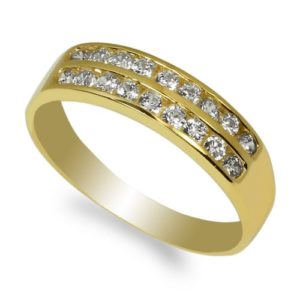
A ring with a channel setting
The channel setting holds diamonds or other stones in a groove, or a channel, in the band of the ring. These stones are smaller and usually serve to complement the bigger center stone, which is usually mounted in another type of setting such as a bezel or prong setting. There are also rings that have only channel-set stones with no center stone.
Advantages: The diamonds or gemstones in a channel setting are secure and well protected from accidental hits or blows. The setting doesn’t have protruding parts such as prongs, which could catch on clothes, hair, or other objects.
Disadvantages: Channel settings are difficult to clean, as it is hard to access the area around and behind the stones. Rings with channel settings are also tricky to resize because the resizing process has the potential to distort the channel – that’s why sometimes it is impossible to resize such rings without damaging the channel.
Bar Setting

A ring with bar-set stones
Diamonds or gemstones in a bar setting are placed in a row and are separated by small metal bars. The bar setting resembles the channel setting in appearance, although the two differ in structure.
The bar setting is designed to hold smaller stones, which can accentuate a bigger center stone, or there may not be a center stone at all (the latter is a popular design for wedding bands).
Advantages: The bar setting provides somewhat better visibility for the stones compared to a channel setting. The setting itself is relatively secure.
Disadvantages: Although this setting is generally safe, it is slightly less so compared to the channel setting, which provides better protection for the stones. Resizing a ring with a bar setting can be tricky.
Pave Setting

A ring with a typical pave setting
The pave setting (pronounced ‘pavei’ – from the French word for ‘paved’) is made with very small diamonds inserted into tiny holes drilled into the ring. The stones are held securely in their place by small droplets of metal placed between the diamonds. The result is a surface studded with small stones which are held at the edges by even smaller prongs.
There is a variation of this setting called “micro-pave,” which is made with diamonds that are even smaller than the ones usually used for pave settings.
Advantages: Pave settings provide additional sparkle to a diamond ring, and the visual effect created by this type of setting is striking. The pave setting is a good choice if you have a center stone that is somewhat lower in brilliance and you want to enhance it.
Disadvantages: Some pave settings are not made very well and their stones may not be held fast by the prongs/metal droplets that are supposed to secure them in place. That’s why you should examine a pave setting with a loupe and watch out for bent or uneven prongs, loose stones, or stones that are misaligned and that overlap. Pave-setting rings can also be hard or even impossible to resize if the small stones cover the shank of the ring.
Flush Setting
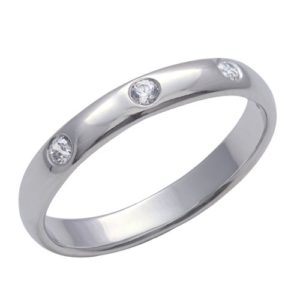
A ring with flush-set stones
The flush setting (also called a gypsy setting) is named this way because the stone is set flush into the ring’s band. The diamond or gemstone is mounted in a hole made in the body of the ring, and the stone fits perfectly in this “nest.”
Advantages: The stone is well protected, so this setting is a good option for people who lead an active lifestyle of work with their hands a lot. The risk of damaging or losing the stone is minimized by the sturdy design.
Disadvantages: The flush setting limits the visible area of the stone and can thus reduce the brilliance of diamonds since only their top is visible.
Invisible Setting
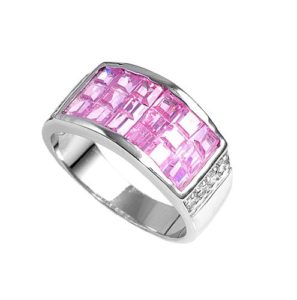
A ring with an invisible setting
In an invisible setting, stones are held by a metal construction hidden underneath them. The result is that there are no visible parts holding the stones in place.
Advantages: The invisible setting looks nice, and it also ensures that gemstones/diamonds are well protected from damage, as stones do not stick out from the mounting and are thus less likely to catch on clothing or other objects.
Disadvantages: Although an invisible setting generally protects stones well from damage, there are invisible settings in which stones are not held very securely and can thus fall out if the ring suffers a strong blow.
In addition, many invisible-set stones are held in place by carving small grooves into their pavilions (the lower body of the gemstone/diamond), in which then parts of the metal frame of the setting are inserted. These grooves may lower the price of the stone if it were to be resold as a loose stone at some point in the future (if you’re not planning on doing that, this is not important).
Last but not least, most of the surface of invisible-set stones is not visible, as it is hidden in the setting. Because there is less visible surface through which light can enter the stone and be reflected, the result is less sparkle compared to, say, a prong-set stone.
When buying a ring with an invisible setting, make sure that its stones are held securely, and be careful when wearing it (as you should be with any type of ring).
Vintage Setting (Antique Setting)
Vintage settings/antique settings are designed to feature elements characteristic of a certain period in the past.
For example, Art Deco rings have elements inspired by the Art Deco style, which was popular from the 1920s to the 1940s.
Other common styles for vintage/antique rings include Victorian, Edwardian, Art Nouveau, and Georgian era styles.
Vintage style settings often include milgrain elements (also known as “millegrain”), which are basically small beads of metal along the edges of the ring.
Another type of design common in antique style settings is the filigree. Filigree rings are decorated with small threads of metal to give the piece of jewelry an antique look.

